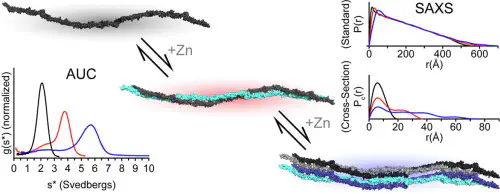
Abstract
Staphylococcus epidermidis is a commensal bacterium on human skin that is also the leading cause of medical device-related infections. The accumulation-associated protein (Aap) from S. epidermidis is a critical factor for infection via its ability to mediate biofilm formation. The B-repeat superdomain of Aap is composed of 5 to 17 Zn2+-binding B-repeats, which undergo rapid, reversible assembly to form dimer and tetramer species. The tetramer can then undergo a conformational change and nucleate highly stable functional amyloid fibrils. In this study, multiple techniques including analytical ultracentrifugation (AUC) and small-angle X-ray scattering (SAXS) are used to probe a panel of B-repeat mutant constructs that assemble to distinct oligomeric states to define the structural characteristics of B-repeat dimer and tetramer species. The B-repeat region from Aap forms an extremely elongated conformation that presents several challenges for standard SAXS analyses. Specialized approaches, such as cross-sectional analyses, allowed for in-depth interpretation of data, while explicit-solvent calculations via WAXSiS allowed for accurate evaluation of atomistic models. The resulting models suggest mechanisms by which Aap functional amyloid fibrils form, illuminating an important contributing factor to recurrent staphylococcal infections.